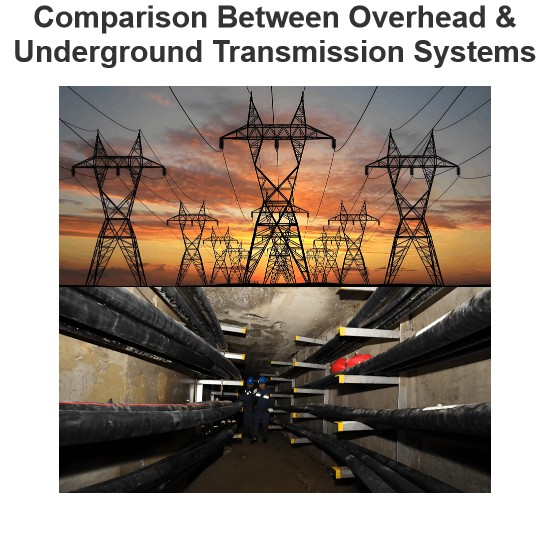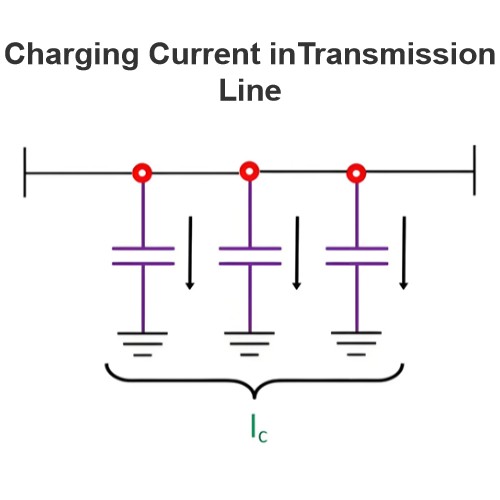Why is the Position of Overhead Conductor Exchanged in a Transposition Tower?
What is Transposition in Transmission Lines?
Transposition in transmission lines involves the deliberate repositioning or twisting of conductors within the line infrastructure. This method is predominantly applied in high - voltage power lines, particularly those operating at frequencies exceeding 60 Hz. The core objective of transposition is to mitigate electromagnetic interference (EMI) and radio frequency interference (RFI) generated by the conductors. These interferences can disrupt nearby communication systems, electronic devices, and cause inaccuracies in measurement equipment. By systematically altering the conductor positions, transposition helps to balance the magnetic fields around the conductors, reducing the strength of the interfering electromagnetic and radio frequency signals, thus ensuring more reliable and efficient power transmission.
Transposition in Transmission Lines: Mechanisms and Benefits
Transposing the conductors within a transmission line serves to enhance the overall symmetry of the line. By doing so, it effectively cancels out certain electromagnetic fields emitted by the conductors. This cancellation significantly reduces the likelihood of interference with adjacent communication systems. As a result, it not only minimizes disruptions to telecommunications but also improves the overall efficiency and reliability of the power transmission infrastructure. This optimization ensures seamless power delivery, safeguarding both the electrical grid and the functionality of nearby electronic devices.
Why and How Are Conductors Swapped in Overhead Power Lines?
Transposition in overhead power lines is achieved by periodically exchanging the positions of the conductors along the length of the transmission line. Specialized equipment and precise techniques are employed to carry out this process. These methods ensure that the conductors are accurately aligned and properly insulated, thereby maintaining the integrity of the power transmission system. This careful execution is crucial to prevent electrical faults and guarantee the safe and efficient transfer of electrical energy over long distances.
When the three conductors of a power transmission line are arranged such that they form the vertices of an equilateral triangle, this configuration is known as symmetrical spacing (as illustrated in the figure below). In the context of symmetrical spacing:

In the case of symmetrical spacing, where the three - phase conductors are arranged at the vertices of an equilateral triangle, the flux linkage and inductances for each phase can be described by identical mathematical expressions. This symmetry ensures that the power flow within the overall power system remains consistent and stable, facilitating efficient and reliable electrical transmission.
Nevertheless, in real - world applications, it is common for the three - phase line conductors not to be evenly spaced from one another. When this occurs, the conductor arrangement is considered unsymmetrical. An example of such an unsymmetrical configuration is depicted below, highlighting the variations in the distances between the conductors. This asymmetry can lead to differences in flux linkage and inductance values among the phases, potentially disrupting the smooth flow of power and necessitating the use of techniques like transposition to mitigate associated issues.
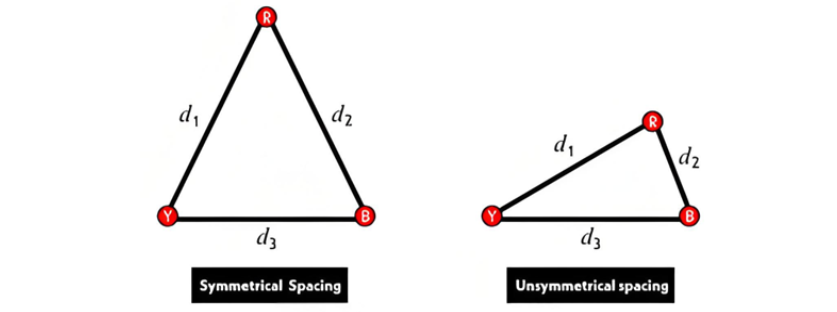
Impact of Unsymmetrical Conductor Spacing and the Role of Transposition
Under unsymmetrical conductor spacing conditions, the flux linkage and inductances of each phase exhibit significant disparities. Even when the phase currents are balanced, these varying inductances cause unequal voltage drops across the three phases. Consequently, the voltages at the receiving end of the transmission line differ among the phases, leading to an uneven distribution of power flow within the electrical system. This imbalance can result in inefficiencies, increased power losses, and potential stress on electrical equipment.
To address these issues, engineers implement a strategic solution known as transposition. This involves periodically interchanging the positions of the conductors along the length of the transmission line. By doing so, each conductor traverses an equal cumulative distance in different spatial locations, effectively averaging out the voltage drops across all conductors. Technically, this cyclic repositioning of conductors is referred to as transposition.
In practice, transposition is executed using specialized structures called transposition towers. These towers are designed to safely and precisely swap the positions of the conductors while maintaining the integrity of the high - voltage transmission system.
The figure below illustrates an example of transposition in a three - phase, two - line setup with six conductors. Color - coded blocks are used to clearly depict the conductors' positions before and after the transposition process. Examining the conductors on the left - hand side of the pole, the color - coding system provides an intuitive way to track how the initial arrangement of the six conductors (across the two lines) is systematically altered through the transposition process.
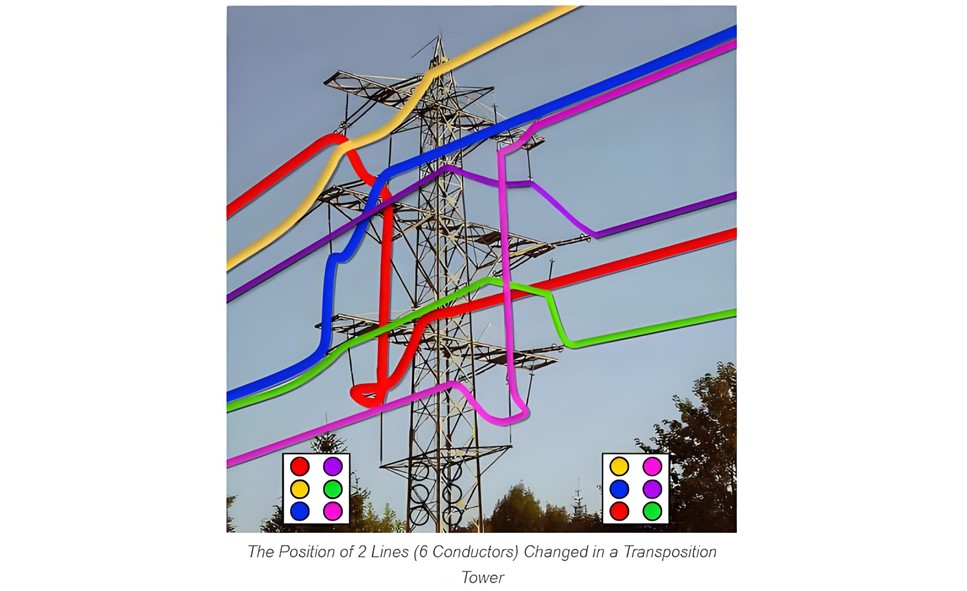
The fig below displays poles for three phase (3-lines) and 2 conductors for transposition purposes.
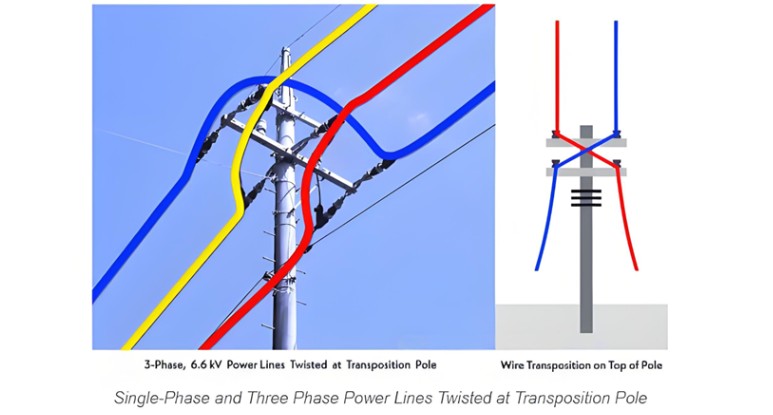
What is the Main Purpose of Transposition in a Transmission Line?
The primary objective of transposing conductors in a transmission line is to diminish the mutual coupling between them, thereby minimizing the overall interference levels. This function is especially critical in multi - phase alternating current (AC) transmission systems. Through transposition, electrical symmetry within the line is established, yielding a multitude of advantages:
Reduced Electromagnetic Interference
Transposition effectively curbs the electromagnetic interference occurring between adjacent conductors. By minimizing this interference, it enhances the transmission line's overall efficiency and performance. This reduction in EMI safeguards nearby communication systems and electronic devices from disruptions, ensuring the seamless operation of both the power grid and other electrical equipment in the vicinity.
Improved Balance
Through the periodic exchange of conductor positions, transposition promotes a more even distribution of currents across each phase. This balanced current flow significantly reduces power losses within the line, optimizing its operational efficiency. As a result, more electrical energy is delivered to the end - users, reducing wastage and enhancing the economic viability of the power transmission infrastructure.
Mitigation of Inductive Effects
Transposition plays a crucial role in countering the detrimental impacts of inductive coupling among conductors. Inductive coupling can lead to unwanted voltage drops and increased power losses, degrading the performance of the transmission line. By mitigating these inductive effects, transposition helps maintain consistent voltage levels and reduces energy dissipation, contributing to a more reliable power delivery system.
Improved Line Stability
By reducing the likelihood of voltage fluctuations and other electrical disturbances, transposition enhances the stability of the transmission line. A more stable line ensures a reliable power supply, minimizing the occurrence of power outages and voltage sags. This stability is essential for maintaining the integrity of the electrical grid and supporting the smooth operation of various electrical loads connected to it.
Related Resources and Engaging Q&A on Power Systems
For those eager to delve deeper into the intricacies of power systems, a wealth of resources awaits. Explore detailed technical manuals, academic research papers, and industry - specific publications that offer in - depth insights into power system design, operation, and optimization. Additionally, engage with our curated collection of thought - provoking questions and answers, covering a wide range of topics from basic electrical principles to the latest advancements in smart grid technologies. Whether you're a student, engineer, or power system enthusiast, these resources will enrich your understanding and spark further curiosity about the fascinating world of power systems.
The Electricity Encyclopedia is dedicated to accelerating the dissemination and application of electricity knowledge and adding impetus to the development and innovation of the electricity industry.


